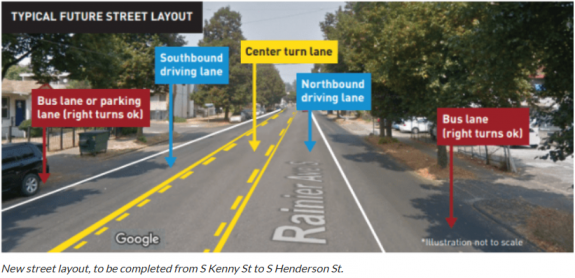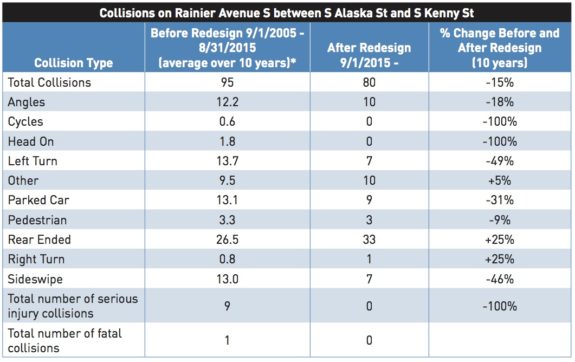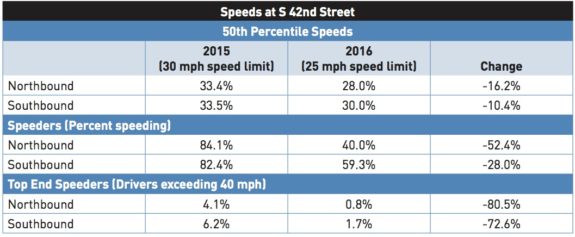Seattle knew 5 years ago that a Rainier Ave safety project would save lives, but is just now starting work
 Rainier Ave S has long held a terrible title: The most dangerous street in Seattle. It saw more crashes per mile than the city's other deadly streets, including Lake City Way and Aurora, despite carrying far fewer trips.
Rainier Ave S has long held a terrible title: The most dangerous street in Seattle. It saw more crashes per mile than the city's other deadly streets, including Lake City Way and Aurora, despite carrying far fewer trips.
During a 6-month study in 2015, on average, there was 1 crash per day that took 45 minutes to clear," SDOT wrote on the project website.
Despite being the central commercial street for many Rainier Valley neighborhoods, Rainier Ave was designed like a highway. With multiple lanes in each direction and no center turn lane, the street encouraged speeding and prioritized people traveling through the neighborhood over people trying to make turns or cross the street. So not only were there a lot of crashes at high speeds, but they were often the most dangerous kind (pedestrian, cyclist, head on and left turn collisions). The result has been decades of people dying and being seriously injured with little to no action to prevent them.
Then in 2015, Seattle redesigned a stretch of Rainier Ave S in Columbia City to reduce collisions along one part the street. It took an enormous amount of political pressure, including a protest in Columbia City, to convince the city to take action and redesign the street. And the results were jaw-dropping. Just by repainting the lines and changing some signs, SDOT's Vision Zero team was able to reduce dangerous collisions and speeding by huge percentages. But most notably, this stretch of the street averaged 9 serious injuries and 1 death every year before the changes. The project reduced that to zero.

 With such an incredible success, the city immediately went out and completed this safety project along the rest of the street, right? The logical and compassionate response to the results in these charts would be to all but declare a public health crisis and fix the rest of the street immediately before more people get hurt. If this were a medical study, researchers would have taken one look at these results, stopped the study and then immediately administered this obviously effective medicine to all patients. Because physicians have a sworn ethical duty to do no harm, and every number in these charts represents a real human being with people who love them. Even one should be considered unacceptable.
With such an incredible success, the city immediately went out and completed this safety project along the rest of the street, right? The logical and compassionate response to the results in these charts would be to all but declare a public health crisis and fix the rest of the street immediately before more people get hurt. If this were a medical study, researchers would have taken one look at these results, stopped the study and then immediately administered this obviously effective medicine to all patients. Because physicians have a sworn ethical duty to do no harm, and every number in these charts represents a real human being with people who love them. Even one should be considered unacceptable.
But there is no Hippocratic Oath for people making transportation policy. It is considered acceptable to knowingly allow people to die preventable deaths in traffic, and therefore such deaths are not treated like an emergency.
SDOT has many excellent and compassionate traffic engineers, and we are lucky to have them working for our city (as you can see in this video produced by Runta News, many SDOT staffers really do get it). But the larger transportation system they work in, from the Feds to the State to the city, is rotten and callous to human life. And even if transportation professionals try to prioritize safety, their work is still largely overseen and controlled by elected executives (Mayor, Governor) and budgeted by legislatures (Council, State Legislature) who may not see traffic safety as the priority or worth the political capital required to make necessary changes. This is why it took a protest to get action on Rainier in the first place. It had to become the politically-expedient choice.
Rainier Ave serves many Black and brown communities. And it's not an accident that while commercial streets in many whiter neighborhoods were given safety upgrades starting in the 1970s, Rainier was ignored. This is part of Seattle's ongoing legacy of systemic racism. And these past few years of delay demonstrate that the city is still in no hurry to right these wrongs.
We reported in February 2017 that the city was beginning outreach to extend the project south of S Kenny Street: So even though the project extension is already a year behind schedule, it's great news that the city is moving forward," Seattle Bike Blog wrote at the time. Then Jenny Durkan was elected mayor in November 2017, and now here we are in September 2020 as the city is preparing to finally make the changes.
It really is great that this project is actually happening this time, with work scheduled this weekend (September 12-13). But it is shameful that the city sat here for a half decade knowing exactly how to prevent deaths and injuries on this street and chose not to.
This has been the story for most of Mayor Jenny Durkan's term. She has paused or cancelled safety projects across the city. And if she didn't pause a project, she certainly didn't put in effort to make it a priority. If the people being injured or killed on this street were a priority, this project would have happened in 2018 at the very latest.
Seattle must do better than this. It cannot take a half decade to fix a deadly street. Our society's relationship with public health has obviously changed dramatically this year, and most people alive today will never think the same way about our collective role in keeping each other safe. Transportation agencies, professionals and policy makers are well overdue for a revolution of their own. And it should be a revolution based on ethics, justice and protecting the health and safety of the people they serve.
We will know this revolution has succeeded when transportation leaders treat a steady flow of people dying and getting seriously injured in traffic with the same urgency as a bridge that's on the verge of collapse.